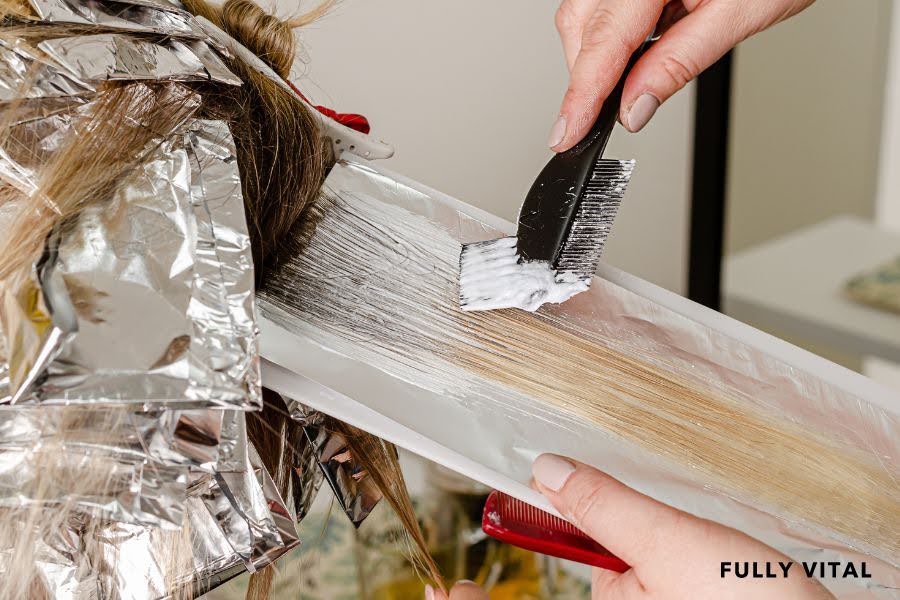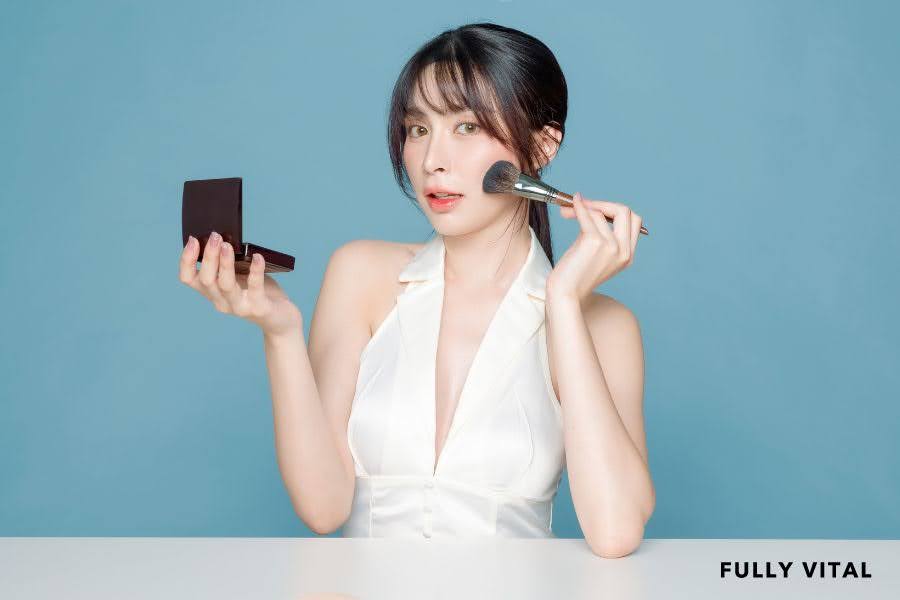
Expert Guide: Can You Safely Bleach Wet Hair? Essential Tips Revealed!
When you want to make your hair lighter, you might wonder if it's okay to bleach it when it's wet.
This guide will help you understand if it's safe to bleach wet hair while keeping your hair healthy.
We'll talk about the basics of hair bleaching and how to get the blonde hair you want without damaging your hair.
Revitalize Your Hair Today! Discover the Power of Fully Vital Hair Growth Products.
Specially Formulated to Stimulate Hair Growth and Restore Thickness.
Experience Healthier, Fuller Hair Now!

I LOVE MY HAIR NOW
FullyVital hair serum and hair vitamins made tremendous improvements in my hair. I truly love my hair now.
Dorit S.,
Understanding Hair Bleaching Basics
Before we address bleaching wet hair, it’s essential to understand the chemical process behind bleaching.
It involves chemical agents that penetrate the hair cuticle, removing the natural pigments and resulting in a lighter hair color.
Overuse or incorrect application can lead to significant hair damage, so it's imperative to approach this process with caution.
Opting for a professional’s help can greatly reduce the risk of damage, as they have the expertise to choose the right type and concentration of bleach for your hair.
Additionally, prepping your hair using Fully Vital’s nourishing products can help strengthen your hair’s natural defenses prior to bleaching.
What Happens During Bleaching?
During the bleaching process, chemical reactions break down your hair's natural melanin, which is responsible for its color.
The oxidation process caused by bleach can weaken hair strands if not done correctly, leading to dryness and breakage.
It's essential to use the right mixture and apply it properly to avoid these adverse effects.
Understanding how to bleach your hair while keeping it as healthy as possible is key, and it starts with the knowledge of the bleaching process itself.
The Role Of Hydrogen Peroxide And Ammonia
Hydrogen peroxide acts as an oxidizing agent, making the hair more permeable to the bleaching process, while ammonia helps to open up the hair cuticle.
These chemicals are essential for the lightening effect but should be used judiciously to prevent hair damage.
It’s recommended to precisely follow the application guidelines to ensure a safe bleaching experience.
The concentration and timing of these chemicals are critical factors that influence the final result of the bleaching process.
Can Bleaching Damage Hair?
Bleaching hair strips it of its natural color and, if overdone, can compromise its structural integrity. This can leave the hair dry, brittle, and more prone to breaking. To mitigate this, it’s important to condition your hair and provide it with the necessary aftercare to restore its moisture and strength. Fully Vital's range of hair care products can be a beneficial part of this restoration process.
Why Professional Help Matters
Professionals have the training and expertise to perform the bleaching process with the least damage to the hair.
They understand how to assess hair type, texture, and condition, and can customize the treatment for your specific needs.
A professional stylist can also provide essential aftercare tips to maintain the hair’s health and color post-bleaching.
Turning to a professional is especially important for more dramatic color changes, or if your hair has been previously colored or treated.
How Fully Vital Can Help
Utilizing the right products before and after bleaching is crucial for maintaining hair health.
Fully Vital offers a range of hair care products designed to nourish and protect hair, making them perfect for pre-treatment conditioning and post-treatment recovery.
These products are formulated with natural, vegan ingredients that help strengthen and revitalize hair, reducing the potential for damage during and after the bleaching process.

Wet Hair Versus Dry Hair: The Main Differences
Whether to bleach wet or dry hair is a decision that can greatly affect the outcome of the bleaching process.
Wet hair tends to be more porous, which means that it might absorb bleach more effectively but also makes it more susceptible to damage.
In contrast, dry hair may not lift as evenly, but it is generally stronger and more resilient during the bleaching process.
For those who prefer to bleach wet hair, understanding these differences is essential to achieve your desired lightness while keeping your hair intact.
Fully Vital's anti-aging approach to hair care can be particularly helpful in maintaining the health of bleached hair, regardless of whether you start with wet or dry strands.
How Hair Porosity Affects Bleaching
Hair porosity plays a significant role in how bleach interacts with your hair.
Wet, porous hair allows the bleach to penetrate more deeply, which can result in a faster lightening effect.
However, this also means that the hair’s cuticle is more open, leaving it vulnerable to damage.
Understanding your hair's porosity will help you gauge how it will react to bleach and how to best protect it.
Why Wet Hair Might Be Preferable For Bleaching
Bleaching wet hair can be less harsh, as the water dilutes the bleach solution—it may help to achieve a more even application with reduced risk of developing patchy areas.
It can also be more efficient, as it requires less product to cover the entire head.
For those with thin or fine hair, this method may lower the chance of damage while providing a gentle lift in color.
The Challenges Of Bleaching Wet Hair
While there are advantages to bleaching wet hair, the increased elasticity of wet strands raises the risk of breakage during the process.
Achieving an even color lift requires careful application, as bleach can spread differently on wet hair.
It is also crucial to remain vigilant with timing, as the reaction process can be accelerated on wet hair.
Tips For Bleaching Dry Hair
For those with thicker or coarser hair, bleaching dry hair may be more appropriate as it allows for greater control and more powerful lightening.
It's important to apply the bleach evenly and watch closely to avoid over-processing, which can result in damage.
Dry hair bleaching often requires more product and precision but can yield dramatic and longer-lasting results.
Fully Vital's Approach to Hair Health
Regardless of whether you bleach your hair wet or dry, maintaining your hair's health is paramount.
Fully Vital promotes products and practices that nourish and strengthen hair, making their approach particularly valuable for those undergoing the bleaching process.
Using their holistic hair care products can help enhance the overall vitality of bleached hair.

Is Bleaching Wet Hair Safe: Exploring The Possibilities
While bleaching wet hair is practiced by some and can lead to satisfactory results, it is not without its potential pitfalls.
The safety of bleaching wet hair hinges on a variety of factors, including the condition of your hair, the quality of the bleaching product, and the care taken during the process.
Expert opinions on the subject can vary, so it’s crucial to weigh the benefits against the possible risks.
When done carefully and with the right precautions, bleaching wet hair can be part of a safe hair transformation journey.
Additionally, Fully Vital’s products can complement the process, ensuring your hair stays nourished and strong.
Understanding The Risks And Rewards
Bleaching wet hair can potentially diminish the potency of the bleach, leading to a subtler lightening process which might be less damaging.
However, the weakened state of wet hair means it can be more prone to breakage and other forms of chemical damage if not handled correctly.
Acknowledge both the pros and cons before deciding to proceed with wet hair bleaching.
How To Mitigate Potential Harm
Using quality bleaching products and following the instructions closely are key to reducing the risk of damage.
Conditioning hair before the process can also reinforce the hair cuticle, providing extra protection against the bleach.
It's important to monitor the hair closely during the process and to thoroughly rinse out the bleach to prevent over-processing.
What The Experts Say
Haircare professionals hold varied opinions on whether it's safe to bleach wet hair, but the overriding consensus is that it requires care and should be performed with the hair's health in mind.
Consulting with a hair expert can provide you with personalized advice based on your hair’s specific needs.
Alternatives To Bleaching Wet Hair
If the risks of bleaching wet hair outweigh the benefits for your hair type, consider safer alternatives like bleaching dry hair or using less aggressive hair coloring options.
Highlights or balayage techniques can offer a lighter touch without the need for full-head bleaching and may be better suited for certain hair types.
Fully Vital's Product Integration
To support the bleaching process, implementing Fully Vital's range of hair care products before and after bleaching can ensure your hair remains in optimal condition.
These products are designed to help fortify the hair, preserve its elasticity, and aid in the post-bleach recovery process, keeping your strands healthy and vibrant.
Pre-Bleaching Care Tips For Wet Hair
Proper preparation is the key to minimizing damage and achieving a graceful lightening effect when deciding to bleach wet hair.
Providing your hair with the necessary nourishment, ensuring its cleanliness, addressing tangles, and conducting a strand test are all critical to a safe bleaching process.
Fully Vital’s commitment to hair health shines through their product offerings, which can prove instrumental in the pre-bleaching phase, providing your hair with the strength it needs to endure the bleaching challenge.
Nourish Your Hair Pre-Bleaching
Strong, well-nourished hair can better withstand the chemical stresses of bleaching.
A deep condition with a hydrating mask or natural oils several days before bleaching can help improve your hair’s resilience.
This is especially important for wet hair bleaching, where the hair's structure can be more susceptible to breakage.
Cleaning Before Bleaching
Ensuring your hair is clean before bleaching helps the product work more efficiently.
However, it's important to avoid heavy conditioners or oils immediately before bleaching, as they can create a barrier between your hair and the bleach.
Opt for a gentle, clarifying shampoo to remove any residue while keeping your strands primed for the treatment.
Detangling And Sectioning
Gently detangle and section your hair before applying bleach to avoid snags and pulls, which can lead to breakage on wet, weakened hair.
This also ensures an even application of the bleach, which is vital for achieving a consistent color throughout.
The Importance Of A Strand Test
A strand test is an essential step in preventing widespread damage and dissatisfaction with the bleaching results.
By testing a small, inconspicuous section of hair first, you can gauge how your hair will react to the bleach and adjust the formula or application method accordingly.
The Role Of Quality Products In Pre-Care
Investing in high-quality bleaching products and using nutrient-rich treatments from Fully Vital can make a significant difference in the health of your hair pre and post-bleaching.
By doing so, you're providing your hair with the best possible defense against the taxing effects of bleach.
Step-By-Step Guide To Safely Bleach Wet Hair
Achieving the lighter shade you envision while keeping your hair's integrity intact requires following a structured process.
From preparing the bleaching mixture to applying and monitoring the product, each step must be carried out with precision and care.
Post-bleaching care is equally important, as it aids in repairing and soothing the hair post-treatment.
Fully Vital's hair care line can be an excellent addition to your post-bleaching regimen, offering the nourishment and repair your hair needs to maintain its luster and fullness.
Preparing The Bleaching Mixture
Accurate measurement and thorough mixing of the bleaching compound are essential steps for a successful lightening process.
Ensuring the correct ratio of bleach to developer can prevent unnecessary hair damage and yield a consistent result.
Dampening Your Hair
Evenly dampen your hair to optimize bleach application; too much water can dilute the product excessively, while too little might not provide the desired softening effect.
Aim for uniformly damp hair to help distribute the bleach more evenly.
Applying The Bleach
Careful, even application of the bleach is crucial, particularly around the hairline and on the tips, areas that can be more vulnerable to damage.
Use a brush and gloves for precision and to protect your skin from irritation.
Timing Is Everything
Keeping a close eye on the processing time is vital, as bleaching wet hair can sometimes lighten hair quicker than expected.
Set a timer and check the progress frequently to avoid over-processing, which could lead to severe damage.
Post-Bleach Care
After bleaching, thoroughly rinse your hair with lukewarm water and follow up with a deep conditioning treatment.
Incorporate Fully Vital’s hair care products that aim to restore hydration and elasticity, helping rejuvenate and protect your hair post-bleach.
By meticulously following this guide and giving your hair the attentive care it deserves, using quality products like those from Fully Vital, you can safely bleach wet hair and achieve the look you aspire to while sustaining your hair's natural beauty and strength.
Discover the Power of Fully Vital Hair Growth ProductsAt Fully Vital, we understand the importance of healthy, vibrant hair. That's why we have developed a range of hair growth products that are designed to stop and reverse the aging of your hair. Here are the key features and benefits of our products:
Experience the power of Fully Vital hair growth products and say goodbye to aging hair. With our science-backed formulas and proven results, you can achieve the healthy and vibrant locks you've always desired. |
Final Thoughts On Can You Bleach Wet Hair
Bleaching wet hair can lighten it, but it requires caution and knowledge.
Understand the process, differences between wet and dry hair, and proper care.
Technique, timing, and quality products matter.
Fully Vital offers hair growth products to maintain hair health.
Aftercare is crucial; use Fully Vital's Hair growth products to replenish and repair.
Plan carefully, seek professional advice, prioritize hair health, and use quality products for beautiful, healthy hair after bleaching.
Check out our recent blogs:
- Biotin For Hair: The Miracle Vitamin You Need In Your Beauty Routine
- Say Goodbye To Hair Damage: Proven Methods For Effective Repair
- The Science Behind Biotin And Hair Growth: How Much Do You Need?
Frequently Asked Questions About Can You Bleach Wet Hair
Can I bleach my hair if it's dyed?
Yes, you can bleach dyed hair, but extra caution is needed to avoid uneven lightening and excessive damage.1
How long should I wait between bleaching sessions?
It's often recommended to wait at least 4-6 weeks between bleaching sessions to prevent over-damaging your hair.2
Will bleaching wet hair give me a different shade than dry hair?
Bleaching wet hair can result in a subtler lightening compared to dry hair, which can lead to a bolder change.3
Can I use a hair dryer to speed up the bleaching process?
Using a hair dryer is not recommended, as the heat can increase hair damage and lead to uneven lightening.4
Do I need to adjust bleach concentration for wet hair?
Dilution isn't necessary as wet hair naturally dilutes the bleach, but you should always follow the product's instructions.5
How can I protect my scalp while bleaching wet hair?
Apply a protective barrier such as petroleum jelly along your hairline and use caution when applying bleach near the scalp.6
What are the safest bleaching products for home use?
Choose products with lower concentrations of peroxide and look for quality, well-reviewed bleach kits designed for home use.7
How do I know if my hair is too damaged to bleach?
If your hair is excessively dry, brittle, or breaking off, it may be too damaged for bleaching and should be strengthened first.8
Can I apply toner to wet hair after bleaching?
Yes, toner can be applied to damp hair after bleaching to adjust the tone and neutralize unwanted hues.9
What should I do if my hair feels gummy after bleaching?
Gummy hair indicates severe damage; stop any further chemical processes and seek professional help for treatment.10
Sources:
- National Health Service (NHS). (2023, November 17). Hair care: Looking after your hair. https://www.gloshospitals.nhs.uk/media/documents/Good_hair_care_advice_GHPI1694_01_22.pdf
- American Academy of Dermatology (AAD). (2023, July 27). Hair bleaching risks and safety tips. https://www.preview.ph/beauty/everything-you-need-to-know-hair-color-bleach-a00232-20201110-lfrm
- Procter & Gamble (P&G). (n.d.). Hair color FAQ. https://pantene.com/en-us/how-to-maintain-at-home-hair-color
- American Chemical Society (ACS). (2019, November 26). Hair science: The chemistry of hair color. https://www.acs.org/pressroom/reactions/library/how-does-hair-dye-work.html
- Clairol. (n.d.). Hair color questions and answers. https://www.clairol.com/en-AU/posts/how-to/answers-to-your-top-colour-questions
- Health Canada. (2019, June 25). Hair dye safety. https://www.canada.ca/en/health-canada/services/cosmetics/hair-dyes.html
- Cosmetics Info. (n.d.). Hair bleach safety data sheets. https://msdsdigital.com/system/files/MSDSIntensiveTint.pdf
- Mayo Clinic. (2023, September 27). Hair loss. https://www.mayoclinic.org/diseases-conditions/hair-loss/symptoms-causes/syc-20372926
- Schwarzkopf Professional. (n.d.). Hair toning: Everything you need to know. https://www.schwarzkopf.com/article-overview/haircolor/toning-hair.html
- Hairfinity. (2023, October 12). How to fix gummy hair after bleaching. https://youprobablyneedahaircut.com/gummy-hair-after-bleaching/







